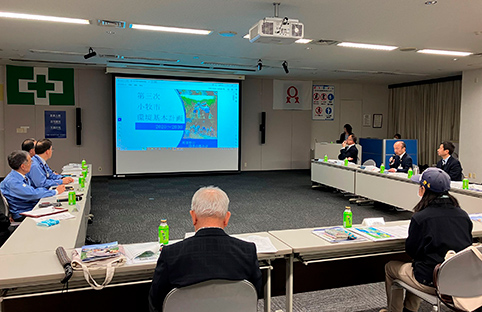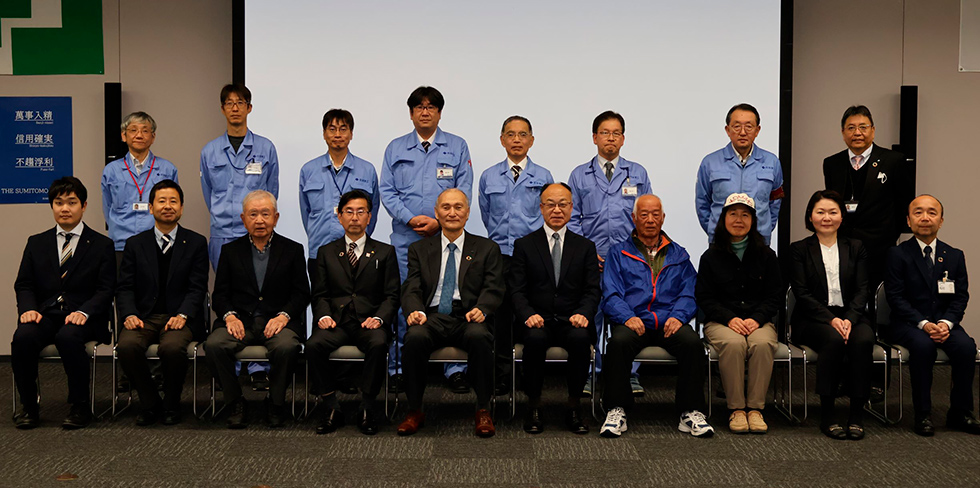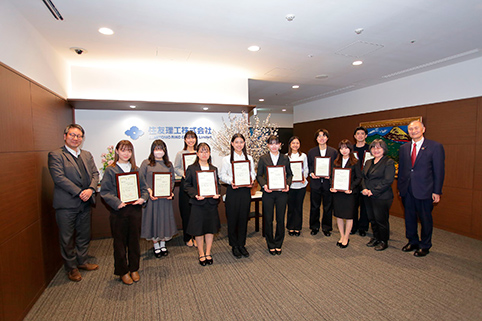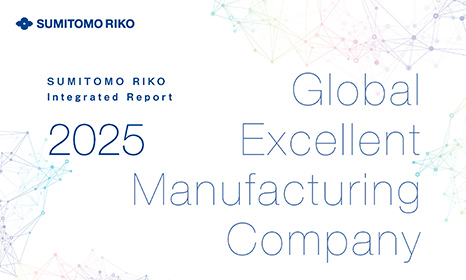Stakeholder Dialogue
Communication with Stakeholders
Shareholders and Investors, Customers, Suppliers and Other Trade Partners, Employees, Local Communities, Global Environment
Komaki City Partnership Dialogue 2024 for Coexistence with Nature

Our group conducts its business activities using a variety of natural blessings, including natural rubber, air, water, and minerals. The “Sumitomo Riko Long-Term Environmental Vision 2050” formulated the year before last recognizes that we have a responsibility to pass on the blessings of nature and the natural environment to future generations without destroying them through our business activities and that we must contribute to coexistence with nature. To realize this vision, we held the second “Komaki City Partnership Dialogue for Coexistence with Nature 2024” this year in Komaki City, Aichi Prefecture, where the Komaki Head Office and Manufacturing Plant are located. To realize this vision, we held the second “Komaki City Partnership Dialogue for Coexistence with Nature 2024” this year in Komaki City, Aichi Prefecture, where the Komaki Head Office and Manufacturing Plant are located. The reason for holding this event was to strengthen and promote collaboration among the various sectors of Komaki City (companies, government, civic groups, universities, etc.) involved in the Symbiosis with Nature project, which we expect will lead to more vibrant Symbiosis with Nature activities.
Related information
[Theme] “From Point Activities to Surface Activities” - Realization of a Society in Harmony with Nature in Komaki City through Diverse Sectors
Komaki City has abundant natural attraction such as Mt. Komaki and the Chigo Forest. However, animals and plants designated as specified alien species have been found in the city, and there are concerns about their impact on native species. To preserve biodiversity in symbiosis with nature, it is important to protect the natural environment, and Komaki City is promoting efforts to conserve and restore nature and restore the ecosystem.
The theme of the second Dialogue was “Continuation: From Point Activities to Surface Activities: Realization of a Society in Harmony with Nature through Diverse Sectors,” and the participants included the Deputy Mayor of Komaki City, Aichi Prefecture, Komaki City Hall, civic groups, experts from universities, and students who will lead the next generation. First, we introduced the activities of each organization and shared the results of the partnership that was initiated by the previous dialogue. Then, we discussed what we can do to make Komaki City “a city where people live together with rich nature that leads to the future,” and worked toward the formulation of common goals.
The theme of the second Dialogue was “Continuation: From Point Activities to Surface Activities: Realization of a Society in Harmony with Nature through Diverse Sectors,” and the participants included the Deputy Mayor of Komaki City, Aichi Prefecture, Komaki City Hall, civic groups, experts from universities, and students who will lead the next generation. First, we introduced the activities of each organization and shared the results of the partnership that was initiated by the previous dialogue. Then, we discussed what we can do to make Komaki City “a city where people live together with rich nature that leads to the future,” and worked toward the formulation of common goals.
Participants

[Facilitator]
Mr. Toshiki Hatano, Advisor of Non-Profit Organization Komaki Citizen's Activity Network
[Stakeholders]
Mr. Kenichi Hiraoka, Deputy Mayor, Komaki City
Mr. Takashi Oshima, Chief, Biodiversity Conservation Group, Nature Conservation Section, Aichi Prefecture
Mr. Yusuke Fukami, Engineer, Biodiversity Conservation Group, Nature Conservation Section, Aichi Prefecture
Mr. Masanori Nakagawa, Group Leader, Environmental Conservation Group, Environmental Measures Section, Komaki City Hall
Mr. Akihiro Wakahara, Engineer, Environmental Conservation Group, Environmental Measures Section, Komaki City Hall
Ms. Mari Kori, Associate Professor, Nagoya University of Economics, Department of Economics
Mr. Hayaki Hashiba, Student, Nagoya University of Economics, Department of Economics
Mr. Yuta Nakashima, Student, Nagoya University of Economics, Department of Economics
Ms. Syuri Okazaki, Student, Nagoya University of Economics, Department of Economics
Mr. Michio Ozawa, Chairman, Oyama River Cleanup Association
Ms. Yoko Baba, Treasurer, Chigo-no-mori Activity Group
Mr. Tamotsu Hashimoto, Representative, Chigorin no Satoyama
[Sumitomo Riko]
Director and Senior Managing Executive Officer, Shinichi Waku
Deputy General Manager, Production Function Headquarters, Yuji Noso
General Manager, Komaki Plant, Kenji Anegawa
General Manager, Environmental Promotion Department, Hideaki Tanahashi
General Manager, Corporate Planning Department, Osamu Wakisaka
Mr. Toshiki Hatano, Advisor of Non-Profit Organization Komaki Citizen's Activity Network
[Stakeholders]
Mr. Kenichi Hiraoka, Deputy Mayor, Komaki City
Mr. Takashi Oshima, Chief, Biodiversity Conservation Group, Nature Conservation Section, Aichi Prefecture
Mr. Yusuke Fukami, Engineer, Biodiversity Conservation Group, Nature Conservation Section, Aichi Prefecture
Mr. Masanori Nakagawa, Group Leader, Environmental Conservation Group, Environmental Measures Section, Komaki City Hall
Mr. Akihiro Wakahara, Engineer, Environmental Conservation Group, Environmental Measures Section, Komaki City Hall
Ms. Mari Kori, Associate Professor, Nagoya University of Economics, Department of Economics
Mr. Hayaki Hashiba, Student, Nagoya University of Economics, Department of Economics
Mr. Yuta Nakashima, Student, Nagoya University of Economics, Department of Economics
Ms. Syuri Okazaki, Student, Nagoya University of Economics, Department of Economics
Mr. Michio Ozawa, Chairman, Oyama River Cleanup Association
Ms. Yoko Baba, Treasurer, Chigo-no-mori Activity Group
Mr. Tamotsu Hashimoto, Representative, Chigorin no Satoyama
[Sumitomo Riko]
Director and Senior Managing Executive Officer, Shinichi Waku
Deputy General Manager, Production Function Headquarters, Yuji Noso
General Manager, Komaki Plant, Kenji Anegawa
General Manager, Environmental Promotion Department, Hideaki Tanahashi
General Manager, Corporate Planning Department, Osamu Wakisaka
Participants' Opinions
Participants' Efforts for Symbiosis with Nature
What we can do for children in the future, aiming to create a “town where nature and people live together.”
- Aichi Prefecture has established various systems and is promoting biodiversity in order to realize "Environmental City Aichi.”
- The Komaki City Biodiversity Regional Strategy is not only for the government, but also for everyone to work together to promote activities.
- Long-term and systematic activities are important for activities in harmony with nature. We would like to work with other companies in the neighborhood to revitalize the activities.
- The University has been conducting surveys of trees and invasive alien species on campus and vegetation along the Oyama River as part of its lectures.
- New ideas are being generated through the connections with various sectors that were established in the previous dialogues.
- This is an environmental and biodiversity activity, but we also aim to promote regional exchange.
- We are also using volunteer matching and other means to allow many people to experience its activities.
- We focus on environmental preservation activities, with the aim of creating people and forests for the future of our children.
- Nature can be easily destroyed, but it cannot be easily created. Therefore, conservation and protection are important.
What we can do for children in the future, aiming to create a “town where nature and people live together.”
- We would like to expand the scope of our activities to create a clean forest that anyone can visit and to promote tree clearing and tree thinning with children.
- We would like to make it possible for members of all ages to participate in activities on an ongoing basis.
- It is difficult for young people to participate in activities alone. It is easier for young people to participate if they are part of school clubs or club teams.
- If a camera is lent to participants in environmental activities for use in social networking services and a photo session is held, this may add value to the program and make it more acceptable to young people.
- If students can have a semi-mandatory experience with nature at school, it will be easier for them to become interested in environmental issues when they grow up.
- For the preservation of ecosystems, it is necessary to have a solid management plan in place in advance.
Facilitator Summary
Human beings were nurtured by nature and are here today. Not only plants, animals, and insects, but also how can human beings live happily? Nature is an indispensable part of human life, where people are born, grow up, have families, and continue to do so. In a destroyed environment, people cannot live happily. This is why various people work together to create such an environment. The Komaki model set by Sumitomo Riko can be one of the themes, can’t it? In the future, while making these kinds of connections, small children will come back to participate in activities. I believe that such a society should be created.
I believe that natural symbiosis is our very life, including the relationship between the community and nature, between people and nature, between family and life and nature, between the company that provides our livelihood and nature, and between the public and the community and nature. It was a time when I strongly felt that exchanging opinions from various perspectives is the very starting point of a “symbiotic society.”
We hope that this dialogue will serve as a catalyst for the realization of a society in harmony with nature in Komaki while connecting with even more people.
I believe that natural symbiosis is our very life, including the relationship between the community and nature, between people and nature, between family and life and nature, between the company that provides our livelihood and nature, and between the public and the community and nature. It was a time when I strongly felt that exchanging opinions from various perspectives is the very starting point of a “symbiotic society.”
We hope that this dialogue will serve as a catalyst for the realization of a society in harmony with nature in Komaki while connecting with even more people.
February 2025
Non-Profit Organization Komaki Citizen's Activity Network
Advisor, Toshiki Hatano
Non-Profit Organization Komaki Citizen's Activity Network
Advisor, Toshiki Hatano
After the Dialogue
It was a very meaningful dialogue with many comments and suggestions from everyone. We strongly believe that nature should be a source of comfort for people and that we should first cherish our nearest environment. We would like to make the most of what we were able to share with you this time and continue to promote dialogue and activities in collaboration with various sectors for the purpose of coexistence with nature and preservation of biodiversity.
Sumitomo Riko Company Limited
The 10th SDGs Student Essay Award by Sumitomo Riko

The “SDGs Student Essay Award by Sumitomo Riko” is a program that began in 2015 as a new social contribution activity to commemorate the change of the company name to Sumitomo Riko and is positioned as a “project to support young people who will lead the future.” (The name of the program at the time of its establishment was “Sumitomo Riko Student Essay Award.”)
We hope that this award will serve as an opportunity for students from all over Japan to learn about social issues and the creation of a sustainable society, provide a place for them to discuss their ideas and contribute to their growth by broadening their perspectives.
In FY2024, we invited papers on the theme of “How to solve social issues through ‘open innovation.’” The screening committee was chaired by Yukari Takamura (Professor at the University of Tokyo's Future Vision Research Center), as well as a panel of experts. In addition, Sumitomo Riko Group employees participated in the preliminary screening to incorporate the ideas and proposals of young people and apply them to management, and five winning essays were selected, including the Grand Prize Award and the Excellence Award.
In January, a round-table discussion was held with the 13 students who received the Grand Prize Award and Excellence Award, the Screening Committee members, and Sumitomo Riko executives. At the round-table meeting, in addition to a presentation and Q&A session on the essays submitted by each winning student, we also gave a presentation titled “Future Conference Toward 2024,” in which we explained the future vision that Sumitomo Riko hopes to realize, which was formulated with an eye toward society in the years 2024 to 2050. This was followed by an exchange of opinions on what the world will be like in 2050, what they would like to be like in that world, and whether they can empathize with Sumitomo Riko's vision of the future.
This year marks the 10th anniversary of this award, and we have received a total of 768 submissions and awarded a total of 76 papers since the first award.
Among the award winners, there are a number of people who are now active not only in Japan but also in other countries and in various cutting-edge industries as a result of what they have discussed and explored in this award. Some of them have told us that winning this award has led them to their current careers. Through the discussion with the award-winning students, we gained a lot by getting into the culture and ideas of today's youth. Dialogue with the students, the next generation of stakeholders, was a valuable opportunity for us to learn what the company should aim for and what social issues the students are interested in.
We hope that this award will serve as an opportunity for students from all over Japan to learn about social issues and the creation of a sustainable society, provide a place for them to discuss their ideas and contribute to their growth by broadening their perspectives.
In FY2024, we invited papers on the theme of “How to solve social issues through ‘open innovation.’” The screening committee was chaired by Yukari Takamura (Professor at the University of Tokyo's Future Vision Research Center), as well as a panel of experts. In addition, Sumitomo Riko Group employees participated in the preliminary screening to incorporate the ideas and proposals of young people and apply them to management, and five winning essays were selected, including the Grand Prize Award and the Excellence Award.
In January, a round-table discussion was held with the 13 students who received the Grand Prize Award and Excellence Award, the Screening Committee members, and Sumitomo Riko executives. At the round-table meeting, in addition to a presentation and Q&A session on the essays submitted by each winning student, we also gave a presentation titled “Future Conference Toward 2024,” in which we explained the future vision that Sumitomo Riko hopes to realize, which was formulated with an eye toward society in the years 2024 to 2050. This was followed by an exchange of opinions on what the world will be like in 2050, what they would like to be like in that world, and whether they can empathize with Sumitomo Riko's vision of the future.
This year marks the 10th anniversary of this award, and we have received a total of 768 submissions and awarded a total of 76 papers since the first award.
Among the award winners, there are a number of people who are now active not only in Japan but also in other countries and in various cutting-edge industries as a result of what they have discussed and explored in this award. Some of them have told us that winning this award has led them to their current careers. Through the discussion with the award-winning students, we gained a lot by getting into the culture and ideas of today's youth. Dialogue with the students, the next generation of stakeholders, was a valuable opportunity for us to learn what the company should aim for and what social issues the students are interested in.


